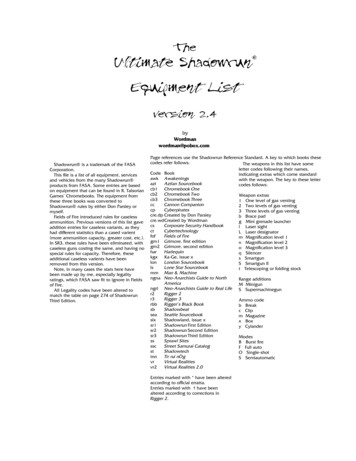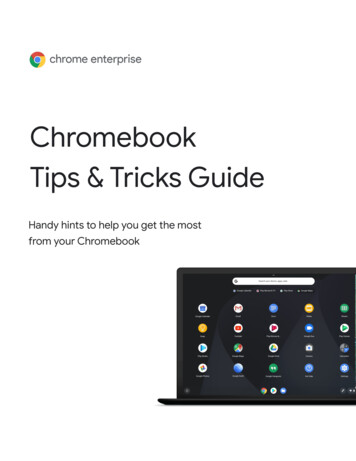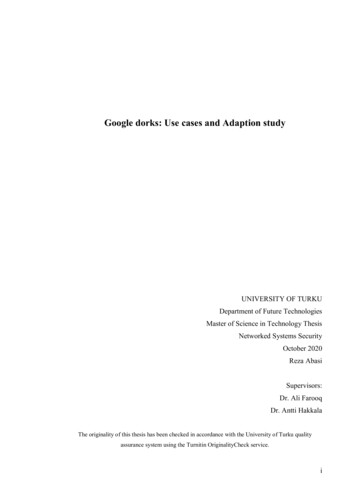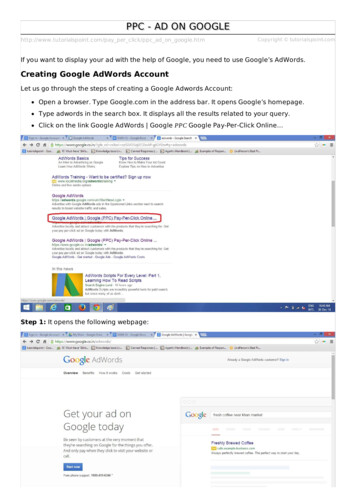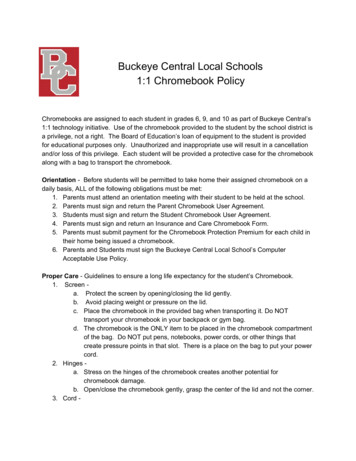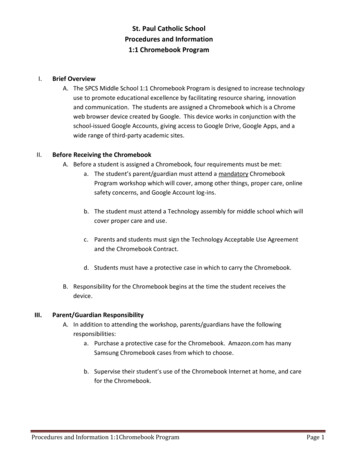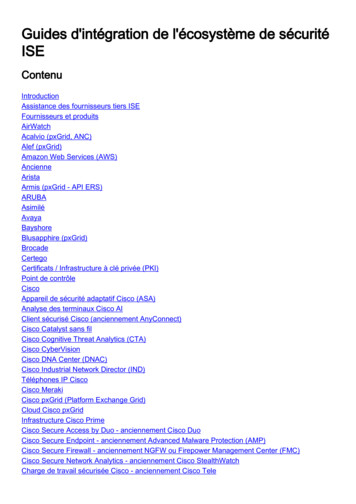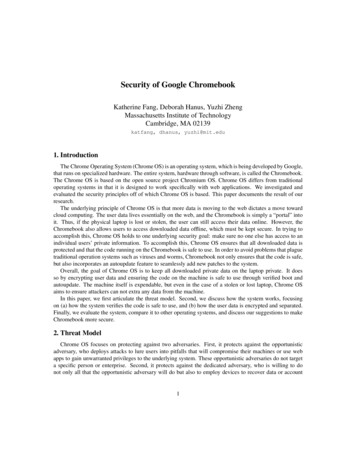
Transcription
Security of Google ChromebookKatherine Fang, Deborah Hanus, Yuzhi ZhengMassachusetts Institute of TechnologyCambridge, MA 02139katfang, dhanus, yuzhi@mit.edu1. IntroductionThe Chrome Operating System (Chrome OS) is an operating system, which is being developed by Google,that runs on specialized hardware. The entire system, hardware through software, is called the Chromebook.The Chrome OS is based on the open source project Chromium OS. Chrome OS differs from traditionaloperating systems in that it is designed to work specifically with web applications. We investigated andevaluated the security principles off of which Chrome OS is based. This paper documents the result of ourresearch.The underlying principle of Chrome OS is that more data is moving to the web dictates a move towardcloud computing. The user data lives essentially on the web, and the Chromebook is simply a “portal” intoit. Thus, if the physical laptop is lost or stolen, the user can still access their data online. However, theChromebook also allows users to access downloaded data offline, which must be kept secure. In trying toaccomplish this, Chrome OS holds to one underlying security goal: make sure no one else has access to anindividual users’ private information. To accomplish this, Chrome OS ensures that all downloaded data isprotected and that the code running on the Chromebook is safe to use. In order to avoid problems that plaguetraditional operation systems such as viruses and worms, Chromebook not only ensures that the code is safe,but also incorporates an autoupdate feature to seamlessly add new patches to the system.Overall, the goal of Chrome OS is to keep all downloaded private data on the laptop private. It doesso by encrypting user data and ensuring the code on the machine is safe to use through verified boot andautoupdate. The machine itself is expendable, but even in the case of a stolen or lost laptop, Chrome OSaims to ensure attackers can not extra any data from the machine.In this paper, we first articulate the threat model. Second, we discuss how the system works, focusingon (a) how the system verifies the code is safe to use, and (b) how the user data is encrypted and separated.Finally, we evaluate the system, compare it to other operating systems, and discuss our suggestions to makeChromebook more secure.2. Threat ModelChrome OS focuses on protecting against two adversaries. First, it protects against the opportunisticadversary, who deploys attacks to lure users into pitfalls that will compromise their machines or use webapps to gain unwarranted privileges to the underlying system. These opportunistic adversaries do not targeta specific person or enterprise. Second, it protects against the dedicated adversary, who is willing to donot only all that the opportunistic adversary will do but also to employ devices to recover data or account1
credentials for malicious purposes. The dedicated adversary may even go so far as to deploy network-levelattacks to attempt to subvert the Chrome OS during device login or update processes. These dedicatedadversaries may target data of specific person or enterprise.2.1. EvaluationWe feel it is reasonable to cover both the opportunistic adversary and those targeting intellectual property.The opportunistic adversary is the more common case, but as more of society moves toward cloud computing, more and more important and secret data will also make the transition. Thus, it is also important tocover the dedicated adversary as it will be impossible to backtrack and strap on the necessary security lateron. It is important to lay the groundwork now.Chrome OS, however, mentions nothing regarding phishing attacks and other online attacks that arecommon in todays world. While it is understandable that an operating system may be unable to preventsuch attacks any more than a browser, it seems odd that Chrome OS will leave this out when it tries to makesome guarantees about the Chromebook being safe to use. Chrome OS pushes the responsibility of securingthe safety in the web-based attacks to the Chrome Browser and contains the effect of the attacks throughautoupdating and verified boot.2.1.1User AnalysisThe main features that Google highlights in the Chromebook marketing videos are the following: no antivirus software or system update needed, simple to use, long battery life and portability. These features implytwo main uses: a primary device for an inexperienced user or a secondary device for an experienced user.The simplicity and lack of maintenance needed for Chromebook makes it a prime candidate for people whoare less familiar with the details of using computers as their primary computing tool. For example, onesgrandmother. On the other hand the the portability and battery life also makes it very attractive to someonewho is more versed in computers to use it as a netbook, mostly a secondary computer.For someone unfamiliar with computers, it is extremely important to ensure the default setting are secureand also make it difficult for this type of user to put their data in risk. While someone who is using theChromebook as a secondary computer might know some basic implications of certain security settings,newer computer users might be attracted to features that are easier to use but likely to drastically reducesecurity.2.2. System overviewThe Chrome browser is the only real “user application” running on the Chrome OS with which theuser interacts. All other interactions with data occur through web applications in the browser. Using thismethodology, Chrome OS inherits the security of the Chrome browser. That is each web app is sandboxedand privilege separated so that each process runs in its own namespace. In addition, the Chrome browserprovides tab isolation and isolated app storage resources.Chrome OS also employs mandatory access control scheme on both the application and system level.Even though the Chrome browser is the only user application running, the mandatory access control ensuresthat the browser will only have access to resources it needs from the user it is currently signed in as. Thisprevents different web apps from messing with each other, and if one breaks, it limits the effects.One of Chrome OS’s major security goals is to ensure that the system is safe to use. The approach ChromeOS uses is verified boot. On boot up, Chrome OS checks that the firmware, kernel, and system data are allvalid by checking signed hashes. In addition, there are two root partitions from which Chrome OS can boot.2
If one is corrupted, the other is still safe to use, and while the system is running from one, it can update theother root partition to a new version in the background.The other major security goal Chrome OS pursues is keeping important information secret. Chrome OSdoes this by keeping the data in a separate partition from the root data. Each user’s data is encrypted usingdifferent keys, thus users can only access his own data.3. Verified Boot & AutoupdateVerified boot is used to ensure that all executed code comes from the Chrome OS source tree, rather thanfrom an opportunistic attacker or corruption. Chrome OS uses verified boot to place a guarantee on whatcode is running, so that if an attacker modifies any portion of the start-up code, it is detected early, preventingthe attacker from controlling the computer across multiple reboots. Verification during boot is performedon-the-fly to avoid delaying system start up. It uses stored cryptographic hashes and may be compatiblewith any trusted kernel. Verified boot can detect changes in the writable firmware, kernel, modules, and filesystem, but not changes to the user’s data. Through this method, Chrome OS can prevent incomplete updates,attacks, corruption, malicious users, and crashes. We discuss how verified boot works on the firmware andkernel level, and then evaluate its security implications.3.1. FirmwareThere are several components to the firmware. First, there is the read-only (R/O) firmware, which is thefirst code that the computer executes on start up. Second, there is the recovery firmware (which is also readonly). Third, there are two writable (R/W) portions of the firmware (A and B). Firmware A is the primaryR/W firmware and is checked first. Firmware B acts as a backup and is copied to A is A is corrupted. Thegeneral flow is for R/O firmware to check the validity of the R/W firmware. If the R/W firmware can beverified, execution will pass to it. Otherwise, the recovery firmware executes.3.1.1Read-only FirmwareVerified boot starts with a read-only portion of firmware, which only executes the next chunk of boot codeafter verification. Chromium OS enforces this guarantee by storing the firmware in an EEPROM. The readonly portion of the firmware, which includes the recovery firmware path, resides in the upper portion of theEEPROM. Since the read-only portion cannot be changed, Chrome OS tries to keep it as small as possible.It contains: the root public key, RSA verification algorithms for various combinations of 1024-8192 bit keysizes and SHA-1/256/512 message digest), SHA hashing algorithm (SHA-1/256/512), a way to write andlock a portion of the NVRAM in the TPM.The root public key is a 8192-bit RSA key and is changed by Google every 4 years. When Google pushesupdates using this key, it can check the SKU of R/O firmware to see what private key it needs to sign with.This key is used as rarely as possible to keep it as secret as possible. Instead, a second 2048-bit RSA signingkey (which is signed by the root key) is used to check most other information.The reason the RSA and SHA algorithms are stored in the R/O firmware is because these algorithms donot change, and storing them in the R/W firmware means that there is a chance of modification.The reason the R/O firmware needs to write and lock the NVRAM is to store counters. There are twomajor counters. First, there is the key version number (K#). The K# is a monotonically increasing number,and increments every time the signing key changes. The second is a firmware version number (F#) whichcomes with firmware updates that is updated every time the firmware changes. Together, K# and F# preventfirmware rollbacks as the attacker cannot replace the firmware with an older version without detection.3
3.1.2Read-Writable Firmware VerificationTo verify the R/W firmware, the R/O firmware checks a header (see Figure 1). This header stores: length of header, algorithm that specifies the key size and the hashing algorithm to use, signing key that is actually used, key version number, and crypto hash, which is a cryptographic hash of the rest of the header.Figure 1. Overview of the data needed by R/O firmware to verify R/W firmware. The header’s hash is signed by the rootkey, which cannot be changed after manufacture. The rest is signed by the signing key specified in the header. [?]In addition, a signature of this header (signed by the root key) is stored, and the R/O firmware verifiesthis header with the root key. It also checks that the key version number in the header is not less than the onestored in NVRAM.Once the header is verified, the R/O firmware can confidently use the signing key to verify other signatures. The signing key is used to sign (firmware version number, length, preamble) as well as to sign thehash of the R/W firmware. The R/O firmware checks that both of these signatures are valid, and then checksthat the firmware version number is valid. Finally, it computes the hash of the of the R/W firmware andchecks it against the signed version. Only when this step is verified does execution pass to R/W firmware.3.1.3Read-Writable FirmwareThe role of R/W firmware is to verify the non-volatile memory. This includes the kernel, initrd, and themaster boot record. These are verified similarly to how R/W firmware is verified. For example, a hash iscomputed over the kernel code and then compared against a signed hash. The signed hash is signed by aseparate kernel key, which, in turn, is signed by the signing key. This key, the initrd key, and other similar4
keys change often to further ensure security. Because they are frequently changed, these keys are stored nextto the kernel and initrd, rather than in the firmware. The alternative would be to use the signing key storedin the R/W firmware. However, this would require a firmware update each time the key changes, which isharder to perform than software updates.3.1.4KernelOnce the firmware has confirmed that the kernel is authentic, the kernel takes over, verifying the rest ondemand. This is done by starting a transparent block device that checks each block as it is needed. Eachblock is 4KB and upon access, it is checked against a cryptographic hash. Once the block is verified, it isstored in the page cache. The collection of block hashes are stored either on a stand alone partition or trailingthe file system.The hash of each section of memory is stored in a Merkle Hash tree. Each hash is a SHA–1 computedover a block. Then each bundle of blocks is hashed. And finally, all the bundles are hashed as well. Thisenables updates in a single block with only a O(logn) overhead rather than having to recompute the a hashof the entire file system each time any file is updated. While SHA–1 is not the best hashing algorithm, thesechecks occur after verified boot has checked very secure hashes and signatures. In addition, it is importantto verify each block quickly as it is needed on demand.Notably, verified boot does not use the TPM; however, it is possible to integrate the TPM. For example,once the kernel starts, it could initialize the PCR registers and use those for further tracking. It would alsobe possible to use this method to seal the disk encryption key used to unseal the users data. If verified bootfails, then it will enter recovery mode using the read-only recovery firmware. It will require user interactionin order to complete the process.3.2. Autoupdate for firmware and softwareAutoupdate is extremely important for the security of the system. Chrome OS can effectively push outsecurity updates and minimize the window of vulnerability rather than waiting for user interaction. Thefirmware and softwares update mechanisms are very similar. Once updated, verified boot can detect whetherthe update was successful or or not.3.2.1Firmware UpdateThe firmware updater is a userspace program that runs on system boot. Generally, the firmware updaterwill run after booting a new image that has new firmware to install. However, it is also possible to forceinstallation of new firmware before an update.As mentioned before, R/W firmware is divided into two parts, A and B. The system uses A primarily anduses B as a backup. That is, if A is invalid, the firmware on B will be copied over to A, and then firmware Awill be used. If there is an update, A will be updated first, and if successful, the update will be copied overto B.3.2.2Root UpdateJust as there are two copies of R/W firmware, there are are two root partitions in addition to a third partitioncalled the “stateful partition” that stores the user data. However, instead of using one primarily and theother only as backup, the system switches between the two root partitions. The one that the user is currentlybooted into will be read only while the second one is called the “install” partition, with which deltas can beapplied by the auto updater. This update occurs after a successful boot. However, the user is not switched to5
Figure 2. Firmware update checks firmware A and B. Firmware A is the primary firmware and will take new updateswhile B acts as a backup copy.the updated partition until after he or she reboots. When it does reboot, if the partition fails to boot a certainnumber of times, the system will overwrite the bad partition with the other one.3.2.3Security evaluationRecall that the goal of verified boot is to ensure correctness of the currently running code. Because thiscorrectness is only checked on boot, there are many attacks which exploit the situation in which the userdoes not shut down the computer after it has been attacked. In addition, only the firmware and signing keyare guaranteed against rollbacks; the kernel is not. We examine a few attacks:User leaves computer locked: If the attacker manages to attack the computer and leaves it on afterwards,then the system remains compromised until the user reboots. Chrome OS suggests that the particularlycautious user reboot often.Replay attack: Although the firmware cannot be rolled back, it is possible to roll back the root partition.Because the hash partition is of the system image currently on the machine, if an exploit is found in someprevious version and the attacker can replace the hash partition and the system image to that previous exploitable version, then verified boot will assume that the system is clean. The attacker might at this pointconfigure the system to auto-open an attack URL to re-exploit the system immediately after reboot. Theattacker has thereby thwarted the verified boot. This can be fixed a number of ways: 1) checking the version6
number to see if it is far too out of date before booting; 2) storing the time that the update happened usingthe TPMs tickstamp blob (however, auto updates cannot currently be customized per download).Attacker switches to developer mode: The attacker can switch the machine to developer mode. It takes atleast 5 minutes to launch into developer mode the first time. These 5 minutes are used both as a deterrentand to wipe the stateful partition. However, after this occurs, then the attacker can run any self-signed codeThe user will not be alerted to this while the system is up and running, so if the attacker leaves the machineon, the user will not notice anything wrong. When the system reboots, the user will get a warning messagethat looks like the system needs to be recovered. However, this message will disappear and automaticallyboot after a set timeout. This attack avenue is still left open if the user 1) takes no action, or 2) does not seethe reboot screen.Overall, verified boot acts as a deterrent to persisting attacks. However, once the attacker gets the usersinformation once, it is possible to attack them in other ways. It may perhaps be better to silently reboot everyso often when the user has put it into locked mode as this will improve the chances of catching an alteredsystem. This could be potentially difficult to time. In our experiences, booting takes 8-10 seconds, which isa reasonable amount of time to wait for a computer to come out of sleep mode. Therefore, rebooting everyso often would not take too much of the users time.4. User Data and AccountsThe main security goal of Chrome OS is to keep the users data secure. Both the data on the cloud andlocally-cached data that must inaccessible to adversaries. Chrome OS keeps access to online data secureby logging in using Google Account API, and the users TPM makes offline logins possible. The local diskis secured by using encrypted files systems with separate keys and directory for each user. Those keys aresecured through a few layers of encryption, utilizing both the TPM and the users password.4.1. LoginDevelopers aimed to make Chromebook both secure and easy to use. For usability, it features SingleSign-On capability to all of Googles online products. To ensure the safety of sensitive network packets, theHTTPS stack authenticates the user through Google Account API to obtain the appropriate cookies for allGoogle services. Once authenticated, the TPM and a hash of the password are used to wrap the magic stringfor future offline logins. In order to guard against network attacks, only the root certificate from GooglesSSL certificates are trusted. To attack through the network, attackers will have to trick the Google registrar.The series of checks can be seen in Figure 3.4.1.1OfflineIf the user tries to log in while offline, the system uses the TPM to check if it can successfully unwrapthe magic string. If the TPM contains the wrapped magic string, the user must have had logged in onthis Chromebook before. For this to work, both the wrapped magic string must be stored on the machinewith the same TPM and have the correct user password. On a successful login, the user will not receivea cookie because there is no internet connection. If the user, while online, has change his password sincehe last logged in, the user must login using his old password in order for the magic string to be decryptedsuccessfully. This is a permissible quirk of the system, because there is no way for Chromebook to find outabout the new password without an internet connection.Login should at least be as secure as logging in using an online browser in other operating systems. Theusers password is authenticated through Google each time before obtaining the cookies that will allow theuser to access his data. If the Google API is somehow attacked or Googles registrar is fooled, a malicious7
IDLOZUDS 730 SDVV PDJLF VWULQJ ! ZUDSSHGBVWU XWKHQWLFDWLRQ 7KURXJK *RRJOH 3,RQOLQHVXFFHVV:UDSV 0DJLF 6WULQJ :LWK 730 DQG DVK RI 3DVVZRUG8VHU (QWHUV 3DVVZRUG6WDUW /RDGLQJ 8VHU 6HWWLQJVRIIOLQH WWHPSW WR 8VH 8VHU 3DVVZRUG WR 8QZUDS 0DJLF 6WULQJVXFFHVVXQZUDS 730 SDVV ZUDSSHGBVWU PDJLF VWULQJ "IDLOFigure 3. The flow diagram of the checks going through the system as a user logs inuser may gain access to the users data; however, that attack would be possible in other systems as well. Ifthat ever happens, Google will have bigger problems than just the security of the Chromebook.4.1.2Auto-LoginChrome has an Auto-login option that allows the user to stay logged on constantly, even over multiple boots.Instead of caching the users password or storing long term cookies on the local drive, the system uses anOAuth token, called the übertoken, increasing security and usability. Without the übertoken, if the passwordis stolen, the user must change his password. In addition, there is no way to quickly invalidate long termcookies, so these cookies might remain fresh too long to reasonably keep the users data private. However,the übertoken can be revoked immediately if compromised, and it does not require additional user actionlike changing ones password.While the system is in the shutdown state, the encrypted übertoken is stored with the system settings, andthen the übertoken can be exchanged for cookies once the computer is back on. During login, the systemnotices existing übertokens and will log the user in directly. Having an übertoken demonstrates that the userhas already been authenticated by Google and will log the user in automatically even while he is offline.Once logged in, the system exchanges the übertoken for a number of Google service cookies so that theuser will not need to provide his password when he requests those services. This process is demonstrated inFigure 4Although this feature increases usability, it compromises security. If the Chromebook gets misplaced orstolen, all of that users data on the cloud will be accessible to whoever holds the Chromebook. Although,theoretically, the ubertoken is revokable, the average user might not immediately understand why and howhe should revoke the token. Instead, they might be more focused on the standard approach of relocating thelost machine, giving attackers a chance to steal data.8
6HWXS2SW LQ XWR /RJLQ RQO\ DFFHVVLEOH LQ ORJJHG LQ VWDWH2EWDLQ 2 XWK XEHUWRNHQ&DFKH 2 XWK XEHUWRNHQ IRU IXWXUH XVH8VDJH/RJLQ QRWLFHV H[LVWLQJ XEHUWRNHQ8VHV WRNHQ WR JHW *RRJOH FRRNLHV IRU VHUYLFHVFigure 4. Diagram shows how auto-login is setup and retrieves cookies4.2. User Data EncryptionThe Chromebook is designed to store most user data in the cloud; however, for performance, someinformation, such as cached web data, local storage for web apps, and user preference settings, is kept inlocal persistent storage. This data must be kept securely in local storage so that even if the adversary stealsa device, there is no easy way for her to read the data in plaintext. Since the data on in the cloud belongsto individual users but is not tied to any computer like traditional operation systems, there is no reason toenable the administrator access to other users data. The aim of data encryption is to ensure that only the usercan access his data.To ensure that only the user can access his data, Chrome OS claims to make the user file encryptionautomatic and mandatory. However, hands-on experience shows that the default is only to encrypt thepassword and not necessarily the synced user data. Chrome OS uses system-level encryption of homedirectories to keep users data safe and separate. Encryption is necessary because even in the case of anattacker, there is little they can to little to get the user data without the necessary user password. Layers ofencryption is used to keep the users data safe as overviewed in Figure 54.2.1Long Term UserWhen each user first logs into a Chromebook, he or she gets a new “vault in which to store his or her data.This “vault keeps each users data separate. The vault is stored in a directory that is a hash of user’s name andsalt and is mounted using eCryptfs when the user logs in. Upon first log in, a set of keys is also created and9
.HUQHO 5DQG1XP JHQHUDWRU 730 HQWURS\UDQGRP QXPEHU)(. ELW (6 NH\UDQGRP QXPEHU)1(. ELW (6 NH\8VHU 3DVVZRUG 6DOW9DXOW .H\VHW (6(QFU\SWHG .H\NVHW6 5DQGRPO\ *HQHUDWHG ELW .H\VHW NH\6\VWHP :LGH 56 .H\ IURP 73056 8VHU 3DVVZRUG DVK ELW,QWHUPHGLDWH (QFU\SWHG .H\8VHU :HDN 3DVVZRUG DVK ELW (6 RQ ODVW ELW3HUVLVWHQW 6WRUDJH)LUVW ELWV(QFU\SWHG .H\VHW .H\Figure 5. High level overview of the the layers of encryption for user data and encryption keysassociated with the vault for encryption and decryption functions. Two of the keys are FEK( file encryptionkey) and FNEK(file name encryption key). These keys are 128-bit AES keys and are created with a randomgenerator from the kernel with some additional entropy from the TPM. These keys are stored in kernelmemory for the duration of the file system mount.The FEK and FNEK create the Vault Keyset, which must be persisted so that it is accessible acrossreboots. To do so securely, each users keyset is encrypted using a randomly generated 256-bit AES keybefore it is stored. That AES key is known as the keyset key, and it is also encrypted before it is stored. Twooptions can be employed to protect the user keyset key: the Scrypt method, or the TPM method. The TPMmethod is preferred, thus well focus on the TPM method in this paper.The first part of the TPM method uses RSA encryption. On the first boot of the Chromebook, a systemwide RSA key is generated and wrapped with TPMs storage root key, which is then discarded. Now, onlythe TPM is able to unwrap the key and access the RSA private key, meaning that only this chip will be ableto do these key operations and get the correct private key. The TPM is also slow, which can limit the rate ofpotential brute force attacks.The second part of the TPM method uses AES encryption. The users password is salted and hashedwith SHA-256. The salt is crucial for security because users passwords have limited entropy. Adding a saltincreases the entropy of the hash, making it harder for attacker to brute force the key. The first 128-bitsofthe SHA-256, also called the weak password hash, will be used as the AES key to encrypt the last 128-bits10
resulting from the RSA encryption. The resulting cypher text can be stored on persistent storage as seen inFigure 5.To read the user data, both the user password and the original TPM is necessary to successfully decryptthe keyset key. The keyset key can then decrypt the vault keyset. The FEK and the FNEK in the valut keysetcan then transparently encrypt and decrypt the users data.Because the keysets are encrypted using the users password, if the user changes his password, the systemmust change the encrypted keysets. When the password changes, the old password must be entered one moretime to decrypt the key before it is re-encrypted with the new password that was authenticated by Googlesaccount API. A randomly generate AES key is more secure than using a users password hash directly becausepasswords have limited entropy across users.4.2.2GuestFor guests, any temporary browser data is stored on tmpfs and all guest browsing all is done in incognitomode. The tmpfs is never stored on disk and is erased once the guest logs out.4.3. User Account ManagementUser account settings must work with the rest of the security efforts. Since each user can only see andedit his own preferences, these settings are stored in his individual storage vault, which can only be accessedwith the vault keyset. When the user logs in, the users preferences are applied. Because there is no way toaccess user data without having the password, certain controls such as wifi preference, must be in the systemsettings. This makes sense if we consider that the system must be able to connect to wifi in order to getGoogle to authenticate the user initially before the password is first supplied.The breakdown of system settings and user preferences is setup as below:System Settings: locale, wifi network, owner, white-list, guest mode, proxiesUser Preference: bookmarks, new tab page, browser settings, apps, extensions, themes, pinned tabs,notifications, printer, thumbnails, auto-fill dataThe “owner” is the first user that logs onto the computer. An RSA key pair is generated and private keyis stored in encrypted home directory of the owner. This key pair protects the system preferences, whichcan only be modified by the owner. All requests to change system setting needs to be signed by the privatekey. Furthermore, system preferences override user preferences, giving the owner more control over what isallowed on the machine.5. Additional ModesUntil now, our discussion has been most r
Chromebook as a secondary computer might know some basic implications of certain security settings, newer computer users might be attracted to features that are easier to use but likely to drastically reduce security. 2.2. System overview The Chrome browser is the only real "user application" running on the Chrome OS with which the user .

